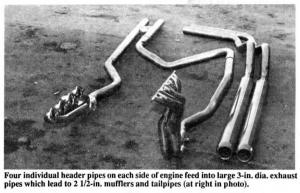1991 - Volume #15, Issue #6, Page #04
[ Sample Stories From This Issue | List of All Stories In This Issue | Print this story
| Read this issue]
Header System For Diesel Pickups
 |
The first-of-its-kind system is designed to virtually eliminate exhaust back pressure on the engine. Four header pipes on each side of the engine feed into large 3-in. dia. exhaust pipes that start about 18 in. behind the engine. A crossover pipe equalizes pressure between the two pipes just before they connect up with 2 1/2-in. dia. mufflers and tail pipes. The system also includes a large air intake hose on the engine and air cleaner adapter on Chevrolet pickups, as well as performance tuning of the fuel delivery system during installation.
"We've tested the system on about 50 Ford and Chevrolet pickups for two years with great results," says Corrigan. "We're concentrating on the Chevrolet 6.2-liter diesel engine and Ford 6.9 and 7.3-liter engines. The new Cummins engine on Dodge pickups already has plenty of horse-power.
"Diesel engines lack horsepower and, since they bum slower than gas engines, they take more time to escalate to desired speeds. The problem is that factory exhaust manifolds create unnecessary back-pressure, reducing power and also causing undesirably high engine temperatures. Factory header pipes are sized to fit the engine's exhaust opening which may be only 1 7/8 in. in dia., resulting in restricted air flow. The header pipes make a sharp 90 degree bend away from the engine which further restricts air flow. Our big 3-in. dia. exhaust pipes collect exhaust from all four pipes to virtually eliminate back pressure, and the header pipes make a gentle bend into the collectors -exhaust airflows freely."
Another problem with factory exhaust systems is that the air intake hose into the air cleaner is too small, says Corrigan. "An inadequate air flow greatly hinders performance of an engine to burn the fuel/air mixture effectively. Some manufacturers use plastic hoses and mufflers that make the air intake appear larger than it really is. Our system uses a large 4-in. air intake hose and a large air cleaner adapter. The combination increases air flow by 300% on Chevrolet's 6.2-liter diesel engine. The extra air flow allows the engine to burn more fuel which boosts power. We also tune up the fuel delivery system to deliver more fuel to the injectors. Fuel economy is improved be-cause less acceleration is required to get the power you need. The result is at least 2 to 4 more mpg."
Corrigan says that after installation a Chevrolet 6.2-liter diesel engine drives "as well as a stock 350cu. in. gas engine. A Ford 7.3-liter diesel engine drives almost like a 460 cu. in. gas engine."
He adds that the exhaust header system helps throughout the engine's power range, but offers the most benefit in the last 200 rpm's. "The point at which a diesel engine normally bogs down, such as when going uphill or pulling a trailer, is when our exhaust system really helps. We increase performance on hills by 80 percent. It eliminates normal diesel engine lag and delivers instant throttle response, much like a gas engine. Dynomometer tests performed on a 1989 Ford F-250 XLT "Lariat" equipped with a 7.3-liter diesel engine show that at 2,200 rpm's, the engine develops 82 hp. After our system is installed, it develops 98 hp. At 3,000 rpm's the difference is 18 hp; at 3,200 rpms, 15 hp; and at 3,400 rpm's, 33 hp. We guarantee a 25% increase in horse-power on a dynomometer when our system is properly installed."
According to Corrigan, the new exhaust system works better than turbochargers and also costs far less. "Turbochargers add pressure on the cylinders and increase exhaust temperatures which can cause wear on engine compartment components, especially when the engine is pulling hard. Extreme heat can cause metal fatigue on the valves and result in a blown head gasket. Turbochargers also sell for several thousand dollars. Our kit sells for only $725 and doesn't add pressure to the cylinders or increase exhaust temperatures. The only possible thing that can go wrong is a blown exhaust gasket.Installation doesn't require expensive block O-ringing or steel shimming like with must turbocharges, and there's no need to cut or add extra oil lines or drain backs." For more information. contact FARM SHOW Followup, Brian's Auto RV Marine & Diesel, PO Box 9333 Tacoma. WA 98409 (ph 206-581-4302).

Click here to download page story appeared in.

Click here to read entire issue
To read the rest of this story, download this issue below or click here to register with your account number.




